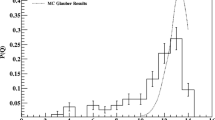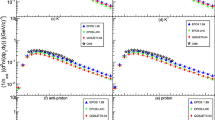Summary
110 meters of K+ tracks have been followed in the energy interval from 40 to 160 MeV. The events observed have been classifieda) 5 K-H collisions;b) 170 elastic and 91 inelastic scatterings;c) 10 charge exchanges;d) 56 decays in flight. The discrimination between elastic and inelastic scatterings has been made with a statistical method discussed in Sect. 3. We have divided also the events in two energy intervals (40 ÷ 90 MeV) and (90 ÷ 160 MeV) in order to study the variation of the cross-section for elastic and inelastic events with the energy (see Table III). From the analysis of the elastic events we have found the existence of a repulsive nuclear potential of about 15 MeV. This result is in agreement with other features relative to inelastic events. From the analysis of the inelastic events we have tried to obtain some information about the elementary K-nucleon cross-section and at present our data seem to indicate that in the energy interval studied, the isotopic stateT=1 is predominant, probably as anS wave. In the higher energy interval there is probably a little contribution of aT=0 state as aP wave.
Riassunto
Sono stati seguiti 110 m di traccia di K+ nell’intervallo energetico da 40 a 160 MeV. Gli eventi osservati sono stati classificati nel seguente modo:a) 5 urti K-H;b) 170 scattering elastici e 91 anelastici;c) 10 scambi di carica;d) 46 decadimenti in volo. La discriminazione tra scattering elastici ed anelastici è stata fatta con un metodo statistico che è discusso in Sez. 3. Abbiamo diviso inoltre gli eventi in due intervalli energetici, da 40 a 90 MeV e da 90 a 160 MeV, al fine di studiare la variazione della sezione d’urto con l’energia per gli eventi elastici e per quelli anelastici (vedi Tabella III e Fig. 4). Dall’analisi degli eventi elastici abbiamo trovato l’esistenza di un potenziale nucleare repulsivo di circa 15 MeV. Questo risultato è in accordo con le caratteristiche relative agli eventi anelastici. Dall’analisi degli eventi anelastici abbiamo cercato di ottenere alcune informazioni intorno alla sezione d’urto elementare K-nucleone, e attualmente i nostri dati sembrano indicare che nell’intervallo energetico studiato, lo stato isotopicoT=1 è preponderante, probabilmente come ondaS. Nell’intervallo energetico più alto è probabile un piccolo contributo di uno statoT=0 come ondaP.
Similar content being viewed by others
References
J. Lanutti, W. Chupp, G. Goldhaber, S. Goldhaber, E. Helmy, E. Iloff, A. Pevsner andD. Ritson:Phys. Rev.,101, 1617 (1956).
Communications ofS. Goldhaber andN. Dallaporta (results for several European laboratories), Part VIProceedings of the Sixth Rochester Conference, 1956. Communications of the plate groups of Bologna, Bristol, Dublin, Göttingen and Padua laboratories, Turin Conference, September 1956.
L. T. Kerth, D. H. Stork, R. W. Birge, R. P. Haddock andM. N. Whitehead:Bull. Am. Phys., Soc. 30, No. 3 (1955).
M. Gell-Mann:Phys. Rev.,92, 833 (1953);K. Nishijima:Prog. Theor. Phys.,12, 107 (1954);M. Gell-Mann andA. Pais:Proceedings of the Glasgow Conference on Nuclear and Meson Physics (London, 1955).
M. Widgoff, A. Shapiro, R. Schluter, D. Ritson, A. Pevsner andV. Henri: preprint andProceedings Sixth Rochester Conference, Part. VI (1956);N. Biswas, L. Ceccarelli Fabbrichesi, M. Ceccarelli, K. Gottstein, N. Varshneya andP. Waloschek:Nuovo Cimento,4, 631 (1956).
G. Costa andG. Patergnani: in the same issue ofNuovo Cimento.
G. A. Salandin: to be published inNuovo Cimento.
The only contrasting result to this evidence as far as we know has been obtained byL. Osborne (Phys. Rev.,102, 296 (1956)) who concludes for the evidence of an attractive potential between K and nucleus. As the deductions ofOsborne are expressed in a very condensed way, we were unable to identify the true reason for the discrepancy.
SeeS. Ceolin andL. Taffara: in the same issue ofNuovo Cimento.
N. Biswas, L. Ceccarelli Fabbrichesi, M. Ceccarelli, M. Cresti, M. Gottstein, N. Varshneya andP. Weloschek:Nuovo Cimento,3, 1481 (1956).
The calculation has been done by Drs.Costa andPatergnani, and we wish to thank them here for having given us their result. We are also grateful to the Göttingen plate group for having communicated to us the collected data (published and unpublished) on K-H scattering from the different laboratories.
R. Hofstaedter:Rev. Mod. Phys.,28, 219 (1956);K. W. Ford andD. L. Hill:Annual Review of Nuclear Science,5, 25 (1955).
Author information
Authors and Affiliations
Rights and permissions
About this article
Cite this article
Ceolin, M.B., Cresti, M., Dallaporta, N. et al. Interactions of K+-mesons with emulsion nuclei between 40 and 160 MeV. Nuovo Cim 5, 402–434 (1957). https://doi.org/10.1007/BF02855249
Received:
Published:
Issue Date:
DOI: https://doi.org/10.1007/BF02855249




